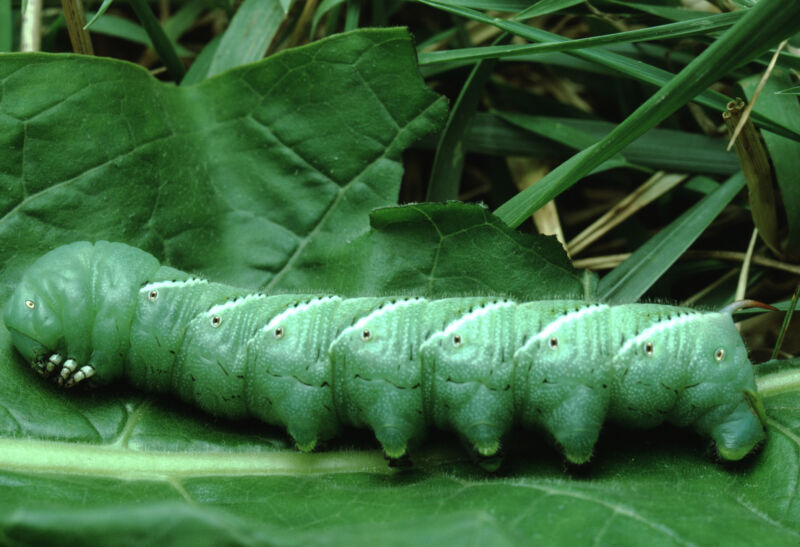What if human blood turned into a sort of rubbery slime that can bounce back into a wound and stop it from bleeding in record time?
Until now, it was a mystery how hemolymph, or insect blood, was able to clot so quickly outside the body. Researchers from Clemson University have finally figured out how this works through observing caterpillars and cockroaches. By changing its physical properties, the blood of these animals can seal wounds in about a minute because the watery hemolymph that initially bleeds out turns into a viscoelastic substance outside of the body and retracts back to the wound.
“In insects vulnerable to dehydration, the mechanistic reaction of blood after wounding is rapid,” the research team said in a study recently published in Frontiers in Soft Matter. “It allows insects to minimize blood loss by sealing the wound and forming primary clots that provide scaffolding for the formation of new tissue.”
Mysterious ooze
Hemolymph has a drastically different composition from vertebrate blood. It is devoid of red blood cells and platelets. The cells that make up hemolymph, known as hemocytes, act like white blood cells in vertebrates, carrying out functions such as eating potentially infectious bacteria and helping form clots over wounds. Some insects have blood richer in hemocytes than others. Even the larval forms of certain species may have more hemocytes in their blood than adults, with many adult butterflies and moths having hemocyte-poor hemolymph compared to the caterpillars.
When experimenting with the sphinx moth caterpillars (Manduca sexta), the researchers placed the caterpillar in a hard plastic sleeve with holes and then made an incision in one of its prolegs. The greenish hemolymph that escaped the wound dripped like water for a few seconds. However, it soon thickened into a viscoelastic fluid that dripped much more slowly. Its final drop did not detach and fall but instead retracted toward the wound.
This all happened within 60 to 90 seconds. Similar results were seen with cockroaches (Periplaneta americana) when the tip of one antenna was severed.
In both species of insects, after the hemolymph retracted, a clot began to form. The scab from this clot became so tough in cockroaches that even a tungsten needle could not penetrate it.
It’s in the blood
To investigate the structure of hemolymph clots, the scientists gathered some of the viscous (but not completely clotted) material from caterpillar and cockroach wounds and examined it using phase-contrast microscopy. Phase contrast enhances contrast and therefore makes it possible to see details (such as cells) in transparent specimens such as hemolymph. The partially clotted hemolymph was made of what are described in the study as “polymeric filaments with embedded hemocytes,” with clots from older wounds being slimier, or thicker, than those from fresher wounds.
Some specimens included pieces of crust from scabs that started to form over healed wounds. These were freeze-dried to prevent any water left from deforming them, then further observed using X-ray, micro-CT, and SEM imaging, which showed that the outer part of the crust, which was most exposed to the air, was more dense. The scab material also contained large aggregates of hemocytes that had assembled themselves into chain structures to form a clot.
How fast can hemocytes start assembling? The team went back and observed viscous but not hardened hemolymph oozing from wounds.
While bleeding stopped after about a minute, hemocytes started to form a scab around three minutes after the formation of the last drop, which retracted after turning into a viscoelastic fluid with polymers strong enough to thicken it and hold it back. Some hemocytes would form pseudopodia (much like amoebas do), which then attached to other hemocytes. The aggregates that resulted made the fluid more and more viscous and eventually formed a scab.
Insect hemolymph is not the only type of bodily fluid that demonstrates viscoelastic properties. Even saliva is more watery when it first leaves the mouth but becomes more viscous with time outside of the body, such as when it stretches down from the end of a dog’s tongue. Human blood is not viscoelastic. However, this study could have implications for human medicine in the future. The Clemson researchers think it is possible that future advances could give us some of the advantages of bugs when it comes to healing wounds.
“We hope that our findings will trigger the interest of biochemists and molecular biologists,” they said, “to design fast-working thickeners for vertebrate blood, including human blood.”
Frontiers in Soft Matter, 2024. DOI: 10.3389/frsfm.2024.1341129



3175x175(CURRENT).thumb.jpg.b05acc060982b36f5891ba728e6d953c.jpg)
Recommended Comments
There are no comments to display.
Join the conversation
You can post now and register later. If you have an account, sign in now to post with your account.
Note: Your post will require moderator approval before it will be visible.